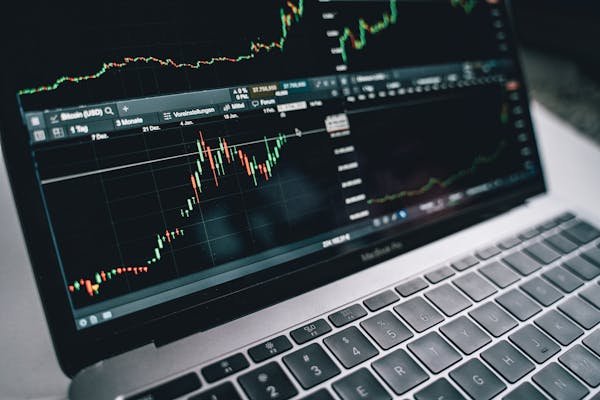In today’s digital age, businesses generate and collect vast amounts of data. However, making sense of this data to drive decision-making can be a daunting task. This is where data visualization comes in. Data visualization transforms complex data sets into visual formats like charts, graphs, and maps, making it easier to understand patterns, trends, and insights. With the advent of artificial intelligence (AI), data visualization has become even more powerful.
Understanding the Basics of Data Visualization
The Evolution of Data Visualization
Data visualization has come a long way from the days of simple bar charts and pie graphs. In the past, visualizations were often static and manually created, which limited their effectiveness and adaptability.
Today, with the advent of AI and advanced analytics, data visualization has evolved into a dynamic, interactive, and integral part of business intelligence. For startup founders, understanding this evolution is crucial for leveraging modern tools effectively.
Modern data visualization tools can process large datasets in real time, providing instant insights and allowing for quick adjustments.
These tools use sophisticated algorithms to identify patterns, trends, and anomalies, presenting them in a visually appealing and easy-to-understand format. This evolution means that businesses can now move from reactive decision-making to proactive and predictive strategies.
The Strategic Value of Data Visualization
For startups, data visualization is not just a tool for making data look pretty; it’s a strategic asset that can drive decision-making and business growth. Visualizing data helps in uncovering hidden patterns, understanding complex relationships, and communicating insights in a way that is easily digestible. This strategic value can be harnessed across various aspects of the business.
For example, visualizing customer data can reveal insights into purchasing behavior, preferences, and trends, allowing for more targeted marketing efforts. Sales data visualization can highlight top-performing products and sales channels, helping to optimize inventory and distribution. Financial data visualization provides a clear picture of revenue, expenses, and cash flow, facilitating better financial planning and resource allocation.
Key Principles of Effective Data Visualization

To leverage data visualization effectively, it’s essential to follow some key principles that ensure clarity, accuracy, and actionable insights. These principles help transform raw data into meaningful visual stories that drive strategic decisions.
Firstly, simplicity is crucial. Overloading a visualization with too much information can make it difficult to understand. Focus on the most important data points and present them clearly. Use colors and labels strategically to highlight key insights without overwhelming the viewer.
Secondly, choose the right type of visualization for your data. Different types of data require different visual representations. For example, line charts are excellent for showing trends over time, while scatter plots are useful for identifying correlations between variables. Understanding which type of visualization best suits your data will enhance its clarity and impact.
Thirdly, ensure accuracy and integrity. The insights derived from your visualizations are only as good as the data they are based on. Always verify the accuracy of your data and avoid manipulating visualizations in a way that could mislead the viewer. Transparency in how the data is sourced and visualized builds trust and credibility.
Tools and Technologies for Data Visualization
The market is flooded with data visualization tools, each offering unique features and capabilities. For startup founders, selecting the right tool is a strategic decision that can significantly impact the effectiveness of your data analytics efforts.
Popular tools like Tableau, Power BI, and Google Data Studio provide robust features for creating interactive and dynamic visualizations. These platforms offer user-friendly interfaces, making it easier for non-technical users to create and interpret visual data. They also integrate seamlessly with various data sources, ensuring that your visualizations are based on up-to-date and comprehensive data.
Advanced tools powered by AI, such as IBM Watson Analytics and Microsoft Azure Machine Learning, take data visualization to the next level. These platforms use machine learning algorithms to analyze data and generate insights automatically. They can also predict future trends and provide recommendations, transforming data visualization from a descriptive to a prescriptive tool.
When choosing a tool, consider factors such as ease of use, integration capabilities, scalability, and cost. A tool that meets your current needs and can scale with your business will provide the best return on investment.
Real-World Applications of Data Visualization
Understanding the basics of data visualization is essential, but seeing it in action is where its true value becomes evident. Real-world applications across various industries demonstrate how effective data visualization can transform business operations and strategies.
In healthcare, data visualization helps in tracking patient outcomes, identifying trends in disease outbreaks, and optimizing resource allocation. For instance, visualizing patient data can highlight the effectiveness of different treatment protocols, guiding medical practitioners in making informed decisions.
In marketing, visualizing campaign performance data allows for quick adjustments and optimization. Marketers can see which channels and messages are driving the most engagement and conversions, enabling them to refine their strategies on the fly. This real-time insight is crucial for maximizing the impact of marketing efforts.
In finance, visualizing financial data provides a clear view of a company’s financial health. This includes tracking revenue, expenses, profitability, and cash flow. Financial visualizations help in identifying cost-saving opportunities, forecasting future financial performance, and making strategic investment decisions.
In supply chain management, data visualization helps in monitoring and optimizing the entire supply chain. Visual dashboards can track inventory levels, supplier performance, and logistics in real-time, ensuring smooth operations and timely deliveries. This visibility is key to maintaining efficiency and meeting customer expectations.
Integrating Data Visualization into Business Strategy
For startups, integrating data visualization into the core business strategy is a game-changer. It involves more than just using visual tools; it requires embedding a data-driven mindset across the organization. This strategic integration ensures that decisions at all levels are informed by accurate and actionable data insights.
Start by establishing a data-driven culture within your organization. Encourage team members to use data visualization tools in their daily workflows and decision-making processes. Provide training and resources to ensure that everyone understands how to interpret and use visual data effectively.
Set up regular reporting and review processes that leverage data visualizations. This could include weekly or monthly dashboards that track key performance indicators (KPIs) and other critical metrics. Regularly reviewing these visual reports ensures that everyone is aligned and focused on the same goals.
Use data visualization to foster collaboration and communication. Visual dashboards can be shared across teams, facilitating discussions and brainstorming sessions. When everyone can see and understand the data, it’s easier to collaborate and make collective decisions that drive the business forward.
How AI Enhances Data Visualization
Automating Data Preparation
One of the significant challenges in data visualization is preparing the data. This involves cleaning, organizing, and structuring the data in a way that makes it suitable for visualization.
AI can automate much of this process, saving time and reducing the risk of errors. Machine learning algorithms can identify and correct inconsistencies in data, fill in missing values, and organize data into meaningful categories.
For example, AI can automatically detect and correct errors in data entry, such as misspelled names or incorrect dates. It can also categorize data based on patterns, making it easier to create relevant visualizations. This automation not only speeds up the data preparation process but also ensures that the data used for visualization is accurate and reliable.
Generating Advanced Visualizations
AI-powered analytics can create more advanced and interactive visualizations than traditional methods. These visualizations can provide deeper insights and a more comprehensive understanding of the data. For instance, AI can generate 3D charts, heat maps, and interactive dashboards that allow users to explore data in more detail.
Advanced visualizations can also include predictive analytics, where AI models forecast future trends based on historical data. This helps businesses anticipate changes and make proactive decisions. For example, an AI-powered dashboard might show a heat map of customer purchases over time, highlighting trends and predicting future buying patterns.
Enhancing User Experience
AI can improve the user experience in data visualization by making it more intuitive and interactive. Natural language processing (NLP) allows users to interact with data visualizations using everyday language. Instead of navigating through complex menus and options, users can simply ask questions and receive visual answers.
For example, a user might type, “Show me the sales trends for the last quarter,” and the AI system will generate a relevant chart or graph. This makes data visualization more accessible to non-technical users, enabling more people within an organization to leverage data for decision-making.
Practical Applications of AI-Powered Data Visualization
Business Intelligence
In the realm of business intelligence, AI-powered data visualization tools can help organizations make data-driven decisions. By visualizing key performance indicators (KPIs) and other critical metrics, businesses can monitor their performance in real-time. AI can highlight anomalies, trends, and correlations that might require attention.
For instance, an AI-powered dashboard might show a sudden drop in sales in a particular region, prompting further investigation. The AI can also suggest potential reasons for the drop, such as changes in market conditions or customer behavior. This allows businesses to respond quickly to issues and capitalize on opportunities.
Marketing Analytics
Marketing teams can benefit greatly from AI-enhanced data visualization. AI can analyze vast amounts of data from various sources, such as social media, email campaigns, and website analytics, to provide a comprehensive view of marketing performance. Visualizations can show the effectiveness of different marketing strategies, highlight successful campaigns, and identify areas for improvement.
For example, AI can visualize customer engagement across different channels, helping marketers understand which platforms are driving the most traffic and conversions. This enables more targeted and effective marketing efforts, maximizing ROI.
Financial Analysis
In finance, AI-powered data visualization can help analysts and decision-makers understand complex financial data. By visualizing financial metrics such as revenue, expenses, and cash flow, AI can provide insights into the financial health of a business. Predictive analytics can also forecast future financial performance, helping businesses plan and budget more effectively.
For instance, an AI-powered tool might visualize monthly revenue trends and predict future sales based on historical data. This helps financial teams identify potential risks and opportunities, making more informed decisions about investments and resource allocation.
Supply Chain Management
AI-powered data visualization can optimize supply chain management by providing real-time insights into inventory levels, supplier performance, and logistics. Visualizing these metrics helps businesses identify bottlenecks, reduce costs, and improve efficiency.
For example, an AI-powered dashboard might show real-time inventory levels across different warehouses, highlighting potential shortages or overstock situations. The AI can also predict future demand based on historical trends, helping businesses plan their inventory more effectively.
Advanced Strategies for Leveraging AI in Data Visualization
Real-Time Data Visualization
One of the most significant advantages of AI in data visualization is the ability to process and display real-time data. Real-time data visualization allows businesses to monitor their operations continuously and make instant decisions based on the most current information. AI algorithms can analyze streaming data, identify patterns, and update visualizations on the fly.
For example, in the retail industry, real-time data visualization can show current sales figures, stock levels, and customer traffic in stores. This enables managers to make immediate adjustments, such as reallocating staff or restocking popular items. In the financial sector, real-time data can help traders and analysts monitor market conditions and respond swiftly to changes.
Predictive and Prescriptive Analytics
While descriptive analytics focuses on what has happened, predictive and prescriptive analytics provide insights into what might happen and what actions to take. AI-powered predictive analytics uses historical data to forecast future trends and outcomes. These predictions can be visualized to help businesses anticipate changes and plan accordingly.
Prescriptive analytics goes a step further by recommending actions based on predictive insights. For example, if predictive analytics forecasts a decline in sales, prescriptive analytics might suggest specific marketing strategies or pricing adjustments to mitigate the impact. Visualizing these recommendations helps decision-makers understand the reasoning behind the suggested actions and their potential outcomes.

Related: Check out our free tools:

Enhancing Collaboration
AI-powered data visualization tools can enhance collaboration within organizations. Interactive dashboards and visualizations can be easily shared across teams, fostering a collaborative environment where data-driven decisions are made collectively. AI can also facilitate collaboration by providing insights that are relevant to different departments.
For example, a sales team might use AI-powered visualizations to identify trends in customer behavior, while the marketing team uses the same data to plan targeted campaigns. Finance and operations teams can also benefit from shared insights, ensuring that all departments are aligned and working towards common goals.
Customizing Visualizations for Different Audiences
Different stakeholders within an organization have varying needs and levels of expertise when it comes to data. AI can help customize visualizations to suit different audiences. For instance, executives might need high-level summaries and trends, while data analysts require detailed, granular data.
AI can automatically generate different versions of visualizations based on user roles and preferences. This ensures that everyone gets the information they need in a format that is easy to understand and act upon. Customizing visualizations also enhances engagement and ensures that insights are effectively communicated across the organization.
Case Studies: Success Stories with AI-Powered Data Visualization
Healthcare: Improving Patient Outcomes
In the healthcare industry, AI-powered data visualization is being used to improve patient outcomes and streamline operations. For example, hospitals are using AI to analyze patient data and visualize trends in disease outbreaks, treatment effectiveness, and patient satisfaction.
One notable case is the use of AI in predicting patient readmissions. By analyzing historical patient data, AI can identify patterns that indicate a higher risk of readmission. Visualizing this data helps healthcare providers implement targeted interventions, such as follow-up care and personalized treatment plans, reducing readmission rates and improving patient care.
Retail: Enhancing Customer Experience
Retailers are leveraging AI-powered data visualization to enhance the customer experience and optimize their operations. By analyzing data from various sources, such as sales transactions, social media, and customer feedback, retailers can gain a comprehensive view of customer behavior.
For instance, a major retail chain used AI to visualize customer purchasing patterns and identify trends in product popularity. This enabled them to optimize inventory levels, plan promotions more effectively, and enhance the overall shopping experience. The visual insights also helped the company identify and respond to regional preferences, tailoring their offerings to meet local demand.
Manufacturing: Optimizing Production Processes
In the manufacturing sector, AI-powered data visualization is being used to optimize production processes and improve efficiency. By analyzing data from sensors and machines, AI can identify patterns and anomalies that impact production.
A global manufacturing company implemented AI-powered dashboards to monitor production lines in real-time. The visualizations highlighted bottlenecks and inefficiencies, enabling the company to make immediate adjustments and reduce downtime. Predictive analytics also helped forecast maintenance needs, preventing equipment failures and minimizing disruptions.
Overcoming Challenges in AI-Powered Data Visualization
Ensuring Data Accuracy
One of the primary challenges in AI-powered data visualization is ensuring data accuracy. Inaccurate or incomplete data can lead to misleading visualizations and poor decision-making. To address this, businesses must invest in robust data management practices.
Start by implementing data validation and cleaning processes to ensure the integrity of your data. Regularly update your data sources and use automated tools to detect and correct errors. Additionally, involve data experts in the process to verify the accuracy of your visualizations.
Managing Data Privacy
Data privacy is a critical concern, especially when dealing with sensitive customer information. Businesses must ensure that their AI-powered data visualization tools comply with data protection regulations, such as GDPR or CCPA.
Implement strong data security measures, including encryption, access controls, and regular audits. Be transparent with your customers about how their data is used and obtain explicit consent when required. By prioritizing data privacy, you can build trust with your customers and avoid legal repercussions.
Integrating with Existing Systems
Integrating AI-powered data visualization tools with existing systems can be challenging, particularly if you have legacy systems in place. To overcome this, work with IT professionals to ensure seamless integration and data flow between systems.
Choose AI tools that offer compatibility with your current infrastructure and provide robust APIs for easy integration. Conduct thorough testing to identify and address any integration issues before full deployment.
Training and Adoption
For AI-powered data visualization to be effective, your team must be able to use these tools confidently. Providing training and support is essential to ensure successful adoption.
Offer comprehensive training programs that cover both the technical aspects of the tools and their practical applications. Encourage a culture of continuous learning and experimentation, where team members feel comfortable exploring new features and sharing their insights.
The Future of AI-Powered Data Visualization

Advancements in AI Technology
The field of AI is continuously evolving, with new advancements enhancing the capabilities of data visualization. Future developments in AI, such as improved natural language processing and advanced neural networks, will make data visualization even more intuitive and powerful.
For example, future AI systems might offer more sophisticated predictive analytics, providing deeper insights into future trends and outcomes. Enhanced interactivity and customization options will make it easier for users to explore data and derive actionable insights.
Increased Accessibility
As AI-powered data visualization tools become more advanced, they are also becoming more accessible to businesses of all sizes. The democratization of AI means that even small and medium-sized enterprises can leverage these powerful tools to gain insights and drive growth.
Affordable AI solutions and user-friendly interfaces are making it easier for businesses to adopt AI-powered data visualization. This increased accessibility will level the playing field, allowing more companies to benefit from data-driven decision-making.
Expanding Applications
The applications of AI-powered data visualization are expanding beyond traditional use cases. From enhancing employee performance and optimizing supply chains to improving customer service and product development, AI-powered visualizations are finding new and innovative applications across various industries.
Businesses that explore these new applications can unlock additional value and gain a competitive edge. By staying at the forefront of AI technology and continuously experimenting with new use cases, companies can drive innovation and achieve long-term success.
Conclusion
Data visualization, enhanced by AI-powered analytics, is a powerful tool that can transform how businesses interpret and act on their data. For startup founders, mastering the basics of data visualization is just the beginning.
The real advantage comes from strategically integrating these tools into your business processes, fostering a data-driven culture, and continuously refining your approach to keep pace with changing needs.
Read Next:
- AI in Content Creation: A Beginner’s Guide
- Social Media in the Workplace: Key Statistics and Best Practices
- How to Create Content with AI Tools
- How Much Time Do We Spend on Social Media? Key Statistics
- Budgeting for Small Business Marketing: Essential Statistics






















Comments are closed.